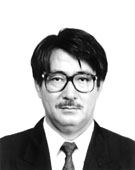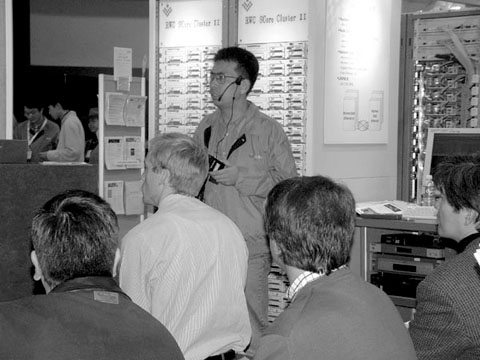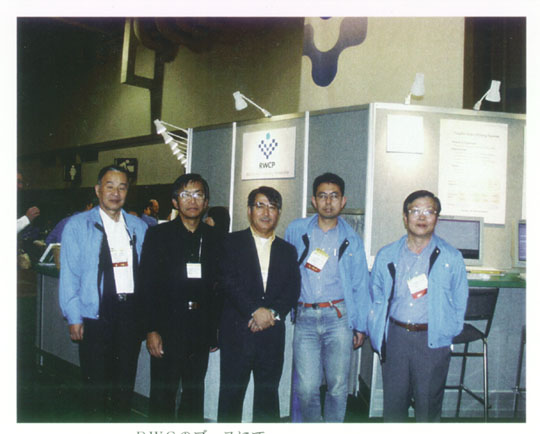
Real World Computing Partnership
Chairperson, Research Committee
(Director of Computer & Communication Media Research Lab., Manager, NEC Corporation)

| Satoshi Goto Real World Computing Partnership Chairperson, Research Committee (Director of Computer & Communication Media Research Lab., Manager, NEC Corporation) |
l Introduction
The RWC Project is a 10-year project that started in 1992, so FY2001 will be its last year and the overall results will be evaluated. The results obtained by the end of the Project will collectively be called the "Final Image", so this issue outlines the key elements of the final image one year before completion to those involved in the project, for their review and comments.
l Goal of the RWC Project
It is a duty of the executives of any national project to clearly explain the contents and results so that anyone can understand them easily. As chairperson of the research committee of the RWC Project since the previous fiscal year, I have discussed the problems involved in the on-going studies at the meeting from the perspective of one executive. In creating the final image, we have tried to make it easy to understand and to ensure the results have worldwide appeal and impact.
In this project, new paradigms - seamless parallel and distributed computing in parallel and distributed computing, and information integration technology in real world intelligence - were proposed and demonstration systems have been developed. Today, the Internet is proliferating rapidly both in Japan and overseas, evolving into mobile and broadband communications both in terms of quantity and quality. The networked society, which will be achieved in this century, should enrich our lives by allowing anyone to accurately and quickly obtain whatever information they need, at any time and from anywhere, for sharing and exploitation.
To obtain information quickly, we need faster computer and network platforms, which means high-performance network super-computing servers, high-speed networking technology, and optical interconnection to connect network devices. The studies on seamless parallel and distributed computing in the Project have been working on developing these fundamental technologies. In addition, to share and exploit information, we need information technologies which can handle large amounts of various multimedia information consisting of speech, motion and still images, as well as documents in an integrated manner with storage, process, and retrieval capabilities for humans to accurately judge valuable information. This is where information integration technology in the Project is useful.
The Project has 97 demonstration systems under research and development, and at the time of writing, some are still at the stage of developing the basic technologies and others are already in actual use. It should be noted that some are already highly valued both in Japan and overseas, and intermediate results are even being utilized while the Project is underway. In this sense, the initial goals of the Project, whose details are given in ³Outline of the Final Image of the Project² below, have been exceeded.
l SC2000 and leading-edge computer
technologies in the world
I had a chance to take part in SC2000 High Performance Networking and Computing (SC2000 in short) held in Dallas, USA, from November 4 to 10. SC is held once a year in the USA, where technical papers on latest super-computer and networking technologies are presented, and companies and research institutes showcase their latest products and prototypes. With approximately 5,000 participants, 153 organizations had booths at this big site. The RWC Project had the third largest booth after NASA and DOE and showed seven prototypes, which were praised by many. The latest trends at SC2000 are reported below, along with how the RWC Project fared at the show.

At SC2000, organizations strive to show how fast their computers operate. The Gordon Bell Prize, an award for operating the fastest machine or accomplishing the highest cost-performance at the time, was awarded to Molecular Dynamic Machine (RIKEN) and Galaxy Simulation Machine (the University of Tokyo) for their peak performance of 1.34 Tflops. The fact that Japanese groups received this prize indicates the advanced level of Japanıs super-computer technologies.

The Earth Simulator, to be operated in 2002 at the speed of 40 Tflops and with the storage of 10 Tbytes, was also shown, since the development of its processor and memory chips have already been completed. Grid, a wide area distributed computing system which connects remotely located super-computers over a network for large-scale computations or support for collaboration, was demonstrated, interconnecting the Electrotechnical Laboratory, JAERI, and Stuttgart University, and revealing how pioneering new computer systems will be used.
Fujitsu and NEC exhibited the latest vector super-computers and the latest scalar parallel computers, with higher performance and functionality than overseas competitors. Japan is generally considered to be the leading country in super-computers and parallel computers, both in research results and product competition. But it should be remembered that the USA invests heavily in national research institutes through NSF and DoD, and has established a system for developing super-high-speed computers with the collaboration of industry, government, and academia. The well-known ASCI and NPACI Projects has received massive funding and manpower to achieve 10-30 Tflops several years from now.
The RWC Project had 6 exhibits on seamless parallel and distributed computing and 1 exhibit on parallel applications. The Tsukuba Research Center brought into the site a machine which consisted of a cluster of 128 PCs with SCore middleware and operated at 64.7 Gflops. It is worth noting that parallel data mining, OpenMP compiler (Omni OpenMP), and parallel scientific programming environment (PROMISE) were also run on SCore, all under research and development in the RWC Project, thus proving the stability of SCore. The SCore-based PC cluster exceeded other similar systems in terms of cost-performance and operability, and is already installed in three organizations including one university in Germany, reflecting the importance of the results from RWC.
The number of PCs per cluster will be increased to 1,000 in the next fiscal year, so it should attract even more attention. Other exhibits included RHiNET, which realizes a local-area system network for high-performance parallel processing, a virtual private parallel and distributed system on the Internet, and a programming environment for heterogeneous distributed systems with vector and scalar processors intermixed to show that the RWC Project is constantly delivering world-class research results in seamless parallel and distributed computing.
l Conclusion
Now that the RWC Project has only one year left, its results are being closely monitored by the rest of the world as well as Japan.
RWC2001, which will be held from October 3 to 5, 2001, will have symposiums and demonstrations. As one of the project executives, Iıd like to present the results of the RWC Project to the world in an easy-to-understand form with great impact. We will do our utmost in the remaining time to make the Project a great success.
